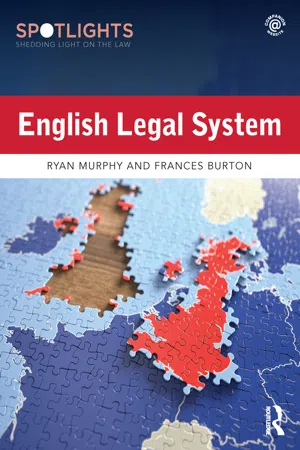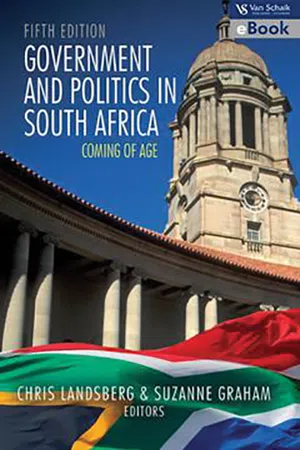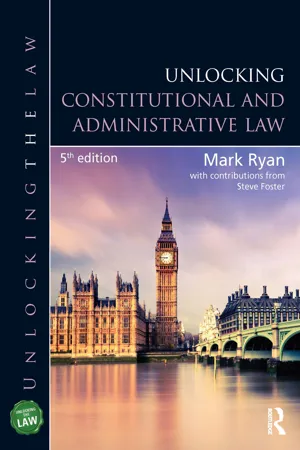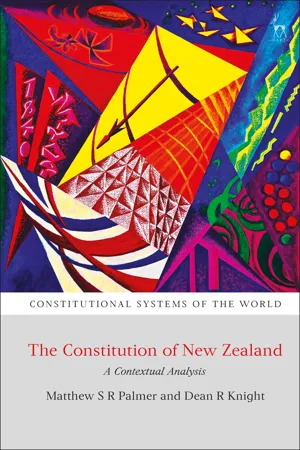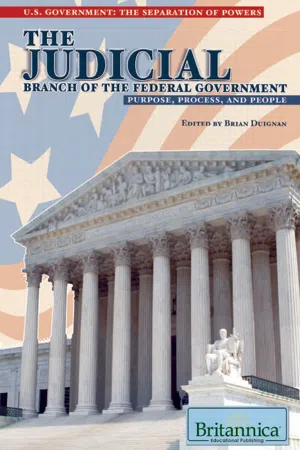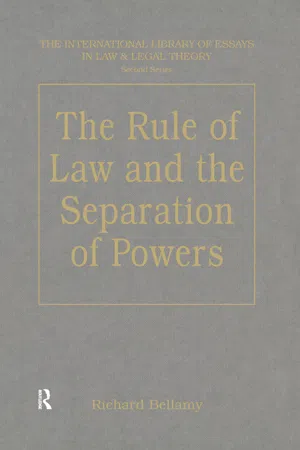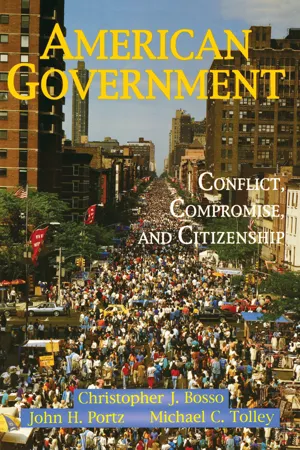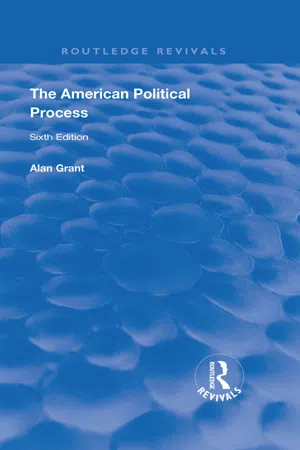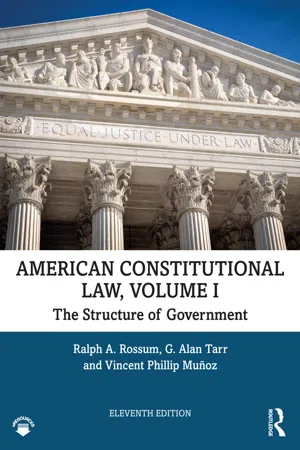Law
Role of Judiciary
The role of the judiciary is to interpret and apply the law, resolve disputes, and ensure justice is served. It acts as a check on the legislative and executive branches of government, upholding the rule of law and protecting individual rights. Through its decisions, the judiciary establishes legal precedents that guide future cases and contribute to the development of the legal system.
Written by Perlego with AI-assistance
Related key terms
10 Key excerpts on "Role of Judiciary"
- eBook - ePub
- Ryan Murphy, Frances Burton(Authors)
- 2020(Publication Date)
- Routledge(Publisher)
The interpretative role played by judges has therefore become a greater part of the judiciary’s work than was once the case. The differing emphasis placed on alternative aspects of the judicial role over time is something that is even recognised by senior members of the judiciary. Lord Woolf once stated that it was ‘one of the strengths of the common law that it enables the courts to vary the extent of their intervention to reflect current needs, and by this means it helps to maintain the delicate balance of a democratic society.’ 2 The development of international (and domestic) fundamental rights protection has also affected the way in which the judiciary approaches its task. 2 Where juries are used, it is the jurors’ role to determine facts though the judge will give them helpful directions to assist them to focus on the issues to be determined. The role of juries is considered in greater detail in Chapter 12. Table 7.1 The Tasks of Judiciary Role Description Fact finders In the vast majority of civil and criminal cases, judges find the facts. 3 This means that they establish, where issues are contested, what the true facts of the case are. This is an important role as it is the material facts that give rise to the legal issue that needs to be resolved. Give interpretation of the law Where Acts of Parliament (or secondary law) are unclear or could bear multiple meanings, judges are called upon to determine the meaning of the law. In this sense, the judiciary gives an abstract interpretation of what the statutory provisions mean. Judges are also responsible, where juries are involved, for explaining the applicable law to the jury. Apply the law Once the facts have been established and an interpretation of the law given, it is normally the judge’s role to apply that interpretation to the specific facts in order to resolve the legal issue in question - eBook - ePub
- Landsberg C, S Graham, Landsberg C, S Graham(Authors)
- 2017(Publication Date)
- Van Schaik Publishers(Publisher)
There is a dispute when we are apprehended for theft. Was it us or somebody else? There is a dispute when we fail to pay our monthly premiums on the car. Did we commit a breach of contract and, if so, what was the damage caused to the car dealer? There is a dispute when we allege that our rights have been infringed upon. Were they in fact infringed upon, and if so, did the infringement comply with the requirements for the lawful limitation of the rights? This is where the third branch of the trias politica, the judiciary (commonly called the courts), comes in. The function of the judiciary is to resolve these disputes by determining what the law is and how it should be applied to every dispute (Shetreet, 1988: 468). In other words, the courts must determine which rule of law applies to the dispute, interpret it and apply it to resolve the dispute. In the process, the courts have the power to adjudicate on our actions as citizens of the State, as well as on those of the other branches of government, the legislature and the executive. The judiciary is the official referee of society (Shapiro, 1975: 328; Du Plessis & Du Plessis, 1990: 86). The constitution provides that the 71 judicial authority of the republic is vested in the courts (section 165(1)). Key concept: Judicial function The judicial function is the function of the courts as impartial referees to resolve legal disputes by determining which rule of law applies and what it means, and by applying it in an authoritative way to the facts of the particular legal dispute. The traditional view was that the courts only applied the law; they did not make it. Today, there is no question that, in the application of a rule of law to an actual case, the courts do have a law-making function (Shapiro, 1975: 342ff). This function is, however, limited and is not as comprehensive as that of the legislature - eBook - ePub
- Mark Ryan, Steve Foster(Authors)
- 2023(Publication Date)
- Routledge(Publisher)
The judicial arm of the constitution must be independent because, by judges ensuring that public bodies act under the law (thereby enforcing the rule of law), they will inevitably come into constitutional conflict with the executive. The independence and impartiality of the judiciary is also linked inextricably to the administration of justice and public confidence in the judicial system to resolve disputes fairly, openly and impartially.One aspect of the rule of law requires the judiciary to protect the individual. In the absence of a written codified constitution, historically the courts have done so by:- Developing common law remedies such as trespass (see Entick v Carrington (1765) at section 4.8.2 ); and
- Interpreting statutory provisions in the light of certain constitutional principles which protect the individual (eg their access to the courts: Chester v Bateson (1920) at section 5.7.2 ).
Under the Human Rights Act 1998, the courts are now charged specifically with applying and upholding the Convention rights of individuals (see Chapter 17 ).13.2.4 Judicial review
Judicial review is linked inextricably with the principles of the rule of law (the courts holding the executive legally to account) and the separation of powers (the courts checking and balancing the actions of the executive – see section 19.2.3 ). It is of paramount importance, therefore, that the judiciary is independent of the executive. In the absence of a codified constitution limiting the actions of the executive, judicial review helps to fill the void by requiring government officials to exercise their executive powers legally, rationally and fairly (see Chapter 20 - eBook - ePub
The Constitution of New Zealand
A Contextual Analysis
- Matthew SR Palmer, Dean R Knight(Authors)
- 2022(Publication Date)
- Hart Publishing(Publisher)
7Introduction – Rule of Law and Forms of Law – Judiciary as an Institution – Judicial Independence and Accountability – ConclusionJudiciaryI. INTRODUCTIONT he judicial branch of government decides what the law means and how it applies to any particular case brought to court. In doing that, judges make law: the ‘common law’. That simple description indicates what is different about the judicial function compared with the legislative and the executive functions. The power of interpreting law, and creating common law, can be significant. But the judiciary’s powers are exercised in the specific context of individual cases. The judges do not initiate cases; they judge the cases brought to court. They must give reasons for, and put their names to, each decision. A court’s decision is always subject to at least one appeal as of right, and the senior appellate courts are composed of panels of judges. As we saw in the last chapter, court decisions can be overridden by legislation if Parliament chooses.In this chapter, consistent with our emphasis on function over form, we start with the adjudicative function of judges and the rule of law. We then turn to the judiciary as an institution within New Zealand’s constitutional system, including its structure and processes, as well as the daily practice of what judges do. Finally, we canvass aspects of the reality of judicial independence and judicial accountability in New Zealand.II. THE RULE OF LAW AND FORMS OF LAWThe question ‘what is law’ is as old as law itself. In simple terms we think of it as publicly stated rules about human behaviour that are enforced by state-imposed sanctions. In reality there is a continuum of sorts. There are many sources of expectations of human behaviour, including those formed and expressed by the evolution of social norms and explicitly demanded by different groups within a society. Here, we look at the different ways the courts determine the nature and meaning of law in the course of adjudication. First, we explain the rule of law as a constitutional principle in New Zealand. - eBook - ePub
The Judicial Branch of the Federal Government
Purpose, Process, and People
- Britannica Educational Publishing, Brian Duignan(Authors)
- 2009(Publication Date)
- Britannica Educational Publishing(Publisher)
When the judiciary does decide a controversy, a body of regulations governs what parties are allowed before the court, what evidence will be admitted, what trial procedure will be followed, and what types of judgments may be rendered. Judicial proceedings involve the participation of a number of people. Although the judge is the central figure, along with the parties to the controversy and the lawyers who represent them, there are other individuals involved, including witnesses, clerks, bailiffs, administrators, and jurors when the proceeding involves a jury.The stated function of the courts is the authoritative adjudication of controversies over the application of laws in specific situations. However, it is unavoidable that courts also make law and public policy, because judges must exercise at least some measure of discretion in deciding which litigant claims are legally correct or otherwise most appropriate. Lawmaking and policy making by courts are most evident when powerful national supreme courts (e.g., those in the United States, Germany, and India) exercise their power of judicial review to hold laws or major government actions unconstitutional. They also can occur, however, when judiciaries are behaving as administrators, even when they are merely ratifying agreements reached out of court. Patterns of settlement for suits between employers and employees may be more favourable to employees than formal law would seem to require, because they are influenced by de facto changes in the law that may result from the decisions by juries or trial judges who may regularly be more sympathetic to workers. Formal laws regulating child custody or financial settlements in divorce cases can similarly be altered over time as juries process the claims of the litigants before them in persistent ways.After a court decision has been made, it may or may not require enforcement. In many cases the parties accept the judgment of the court and conform their behaviour to it. In other cases a court must order a party to cease a particular activity. The enforcement of such orders is carried out by the executive branch and may require funding from the legislative branch. - eBook - ePub
The Danger of Being a Gentleman (Works of Harold J. Laski)
And Other Essays
- Harold J. Laski(Author)
- 2014(Publication Date)
- Routledge(Publisher)
That is why revolutionary epochs have always been associated with hostility to the judiciary; for the mind of the judiciary is always bent to a service the revolution has come to change. At bottom, the judicial function is a political one. It seeks to protect the State-purpose from invasion. Thereby, it is bound, from its nature, to look to the past rather than to the future; its members cannot prepare the ground for new forms of social organization which depart at all radically from the central tradition. And judges, as Mr. Justice Holmes has pointed out, 31 tend in any case to be elderly men who do not easily welcome innovations to which they are unaccustomed. By the time they reach positions of judicial authority they are unlikely to depart at all widely from the groove in which earlier years have set their opinions. Mr. Justice Miller has told us how difficult, in his experience, it was for lawyers who had been counsel for railroad interests to forget, when they reached the Bench, that this affiliation had ceased. 32 But below a simple illustration of this kind there lies the deeper truth that what Mr. Justice Holmes has termed the “inarticulate major premisses” of the judiciary are toughly resistant to new ideas. Collected Papers, p. 295. Cf. the article on his opinions by Professor Fairman, Political Science Quarterly, Vol. 50, p. 15. V What conclusions emerge from this discussion? The essence of the judicial function, I have argued, is to give a logical form to conclusions which already flow, in their large outline, from the nature of any given State. The judge, no doubt, has a certain elbow-room within this outline; but the degree of his movement is always severely limited by it. That limitation, moreover, is further emphasized by two things - eBook - ePub
- Richard Bellamy, Richard Bellamy(Authors)
- 2017(Publication Date)
- Routledge(Publisher)
49 The core of the thesis is to be found in this very notion of principled adjudication. It requires that the courts make decisions which are reasoned and public. But the real nub of the idea is captured in the following quotation:In insisting that judicial decisions should be not only faithful but also principled, I am suggesting that the function of the rule of law is to facilitate the integration of particular pieces of legislation with the underlying doctrines of the legal system … A particular reform of police powers to search for prohibited drugs … should be applied in a manner which is both faithful to the legislative purpose and principled in integrating it with traditional doctrines of the liberties of the citizen.50This aspect of the judicial function is justified in part by the need to ensure that there is a coherence of purpose within the law.51 It is also held to be justified in order to mix52 “the fruits of long-established traditions with the urgencies of short-term exigencies”. It is precisely because legislatures can be susceptible to short-term influences, whether generated by elections or the need to respond quickly to public pressure, that the courts should have a role as the guardians of longer-term tradition.53What then of the place of civil rights within this vision of the rule of law? Raz is careful in this respect. He states that the protection of such rights is partly presupposed and partly implied by the preceding analysis.54 The analysis presupposes such rights in that Raz’s present discussion of the rule of law is confined to democratic societies, and a society cannot be democratic without the existence of such rights. The analysis implies the existence of such rights because “in insisting on the integration of legislation and other current measures with legal tradition enshrined in doctrine, the rule of law respects those civil rights which are part of the backbone of the legal culture, part of its fundamental traditions”.55 - eBook - ePub
American Government
Conflict, Compromise, And Citizenship
- Christopher J Bosso, John Portz, Michael Tolley(Authors)
- 2018(Publication Date)
- Routledge(Publisher)
Römer v. Evans (1996) on the status of homosexuals—all have influenced the political debate over the government’s role in promoting improved race relations, law and order, gender equality, and the rights of other minorities. In each of these cases the Court has acted as a political as well as a judicial institution.In fact, candidates for office at every level of government have had to respond to these decisions in one way or another, whether by voicing their agreement with the Court or by registering their disagreement and promising to promote change if elected. The Supreme Court has helped to establish public policy and will continue to help define and influence the political agenda for generations to come. In short, judicial politics is a dimension of American politics in general, another avenue for resolving the disputes that inevitably arise in a large and complex society.SUMMARY
- ◗ Courts are as much political as legal institutions, as can be seen in the four functions they fulfill: social control, dispute settlement, social engineering, and regime maintenance.
- ◗ The judiciary consists of a dual system of state and federal courts, a structure that reflects the political system’s principle of federalism.
- ◗ The process of advancing a case through the federal judiciary is an arduous one, with relatively few cases obtaining review by the Supreme Court. Should at least four of the nine justices agree to hear the case, the Court then holds oral argument, after which the justices discuss the case among themselves. In cases in which there is no unanimity, the respective sides produce majority and dissenting opinions that explain their differing perspectives. Sometimes a justice who votes with the majority will produce a concurring opinion, in which he or she offers a somewhat different perspective than the majority opinion.
- ◗ The professional qualifications of judicial nominees are important, but other factors, including political ones, also have an influence. Partisanship and ideological conflict help explain the occasional struggles over presidents’ nominations to the Supreme Court.
- ◗ Marbury v. Madison
- eBook - ePub
- Alan Grant(Author)
- 2019(Publication Date)
- Routledge(Publisher)
The Supreme Court’s involvement in the downfall of President Nixon is an impressive illustration of its role in the American political system. It acted as the highest court of appeal to determine what the Constitution and the law meant when the ruling of a lower court was challenged. It was involved in the process of law adjudication, and its role as the final arbiter of the Constitution is essential as parts of the written document are ambiguous and require interpretation. In this particular case, the doctrine of ‘executive privilege’ is not even mentioned specifically in the Constitution, and the Supreme Court had to decide whether the independence of the executive branch, implied by the separation of powers principle, extended to an absolute privilege of confidentiality of Presidential communications.The compliance by the President with the Supreme Court’s decision on the release of the sub-poenaed tapes demonstrated the unique position which the Court had achieved. The executive and legislative branches of government accept the decisions of the Supreme Court even though it has no direct way of enforcing its decisions on the other institutions. The Court has consistently found support in the popular belief that the judiciary stands apart from the elected institutions and defends the fundamental law of the Constitution, and the level of respect and confidence in the Court’s integrity has been an important factor in this development.The Nixon case confirmed once again the importance of the separation of powers doctrine and the role of an independent judicial branch in preventing an arbitrary abuse of power by the executive authority. The Supreme Court’s decision effectively led to the resignation of a President who had lost the confidence of the people, but it was the culmination of a number of searching investigations by the judicial system. The District Court of John Sirica in Washington DC played a particularly crucial role in revealing the extent of the Watergate affair, and the lengthy legal procedures that went on for a couple of years after the original break-in showed the tenacity and effectiveness of the judicial process. The independence of the Supreme Court was also demonstrated by the fact that three of the eight justices who voted against the President in the case (Justice Rehnquist played no part in the discussions) were, in fact, appointed by Richard Nixon himself. - eBook - ePub
American Constitutional Law, Volume I
The Structure of Government
- Ralph Rossum, G. Alan Tarr, Vincent Phillip Munoz(Authors)
- 2019(Publication Date)
- Routledge(Publisher)
The Legislature would be possessed of power to “prescrib[e] the rules by which the duties and rights of every citizen are to be regulated,” but the power of “[t]he interpretation of the laws” would be “the proper and peculiar province of the courts.” The Federalist No. 78. The Judiciary would be, “from the nature of its functions, … the [department] least dangerous to the political rights of the constitution,” not because its acts were subject to legislative correction, but because the binding effect of its acts was limited to particular cases and controversies. Thus, “though individual oppression may now and then proceed from the courts of justice, the general liberty of the people can never be endangered from that quarter: … so long as the judiciary remains truly distinct from both the legislative and executive.” The Federalist No. 78. Judicial decisions in the period immediately after ratification of the Constitution confirm the understanding that it forbade interference with the final judgments of courts…. Section 27A(b) effects a clear violation of the separation-of-powers principle we have just discussed. It is, of course, retroactive legislation, that is, legislation that prescribes what the law was at an earlier time, when the act whose effect is controlled by the legislation occurred—in this case, the filing of the initial Rule 10b-5 action in the District Court. When retroactive legislation requires its own application in a case already finally adjudicated, it does no more and no less than “reverse a determination once made, in a particular case.” The Federalist No
Index pages curate the most relevant extracts from our library of academic textbooks. They’ve been created using an in-house natural language model (NLM), each adding context and meaning to key research topics.
